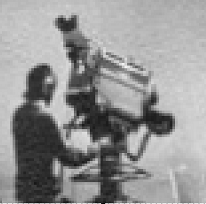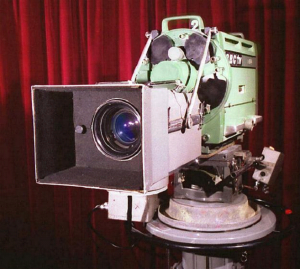Background
A zoom lens is a mechanical assembly of lens elements for which the focal length (and thus angle of view) can be varied, as opposed to a fixed focal length lens.
A true zoom lens, also called a parfocal lens, is one that maintains focus when its focal length changes. A lens that loses focus during zooming is more properly called a varifocal lens.
A loss that zoom lenses suffer is in wide open aperture image quality.
[Wikipedia]
Alasdair Lawrance
I think the Varotal 1 was sometimes called the “Dog Kennel”, I remember one in Cardiff which entailed removing the complete turret assembly from a Marconi Mk 3, and the controls were connected by straight rods.
The V2 was perhaps 5:1, with a horrible combined zoom and focus thingie.
The V3 was the 4-20 / 8-40 but a much longer device. I’ve never heard of a V4, it might be a prototype never put into production.
Peter Cook
There was no V4. The V3 was my first experience on a live OB. Camera 3 personality camera on Centre Court at Wimbledon, 1964. A far cry from the ‘Arched Window’ and a veritable baptism by fire, or at least a sweaty palm job. Never has an hour and a half gone so swiftly or been adrenaline filled. We had a remote lever and cable to change ranges mounted on the panning handle. After some months practice this change could be snatched in the same way as a turret lens change to emulate a mixer cut. Such things have long been consigned to history.
Alex Thomas
I remember the Taylor Hobson Varotal 5 with its concave front element. I also remember using the Varotal 3 in the TV Theatre on “This is your life” to get CUs of guests, family, etc from a ped mounted camera situated near the cam left proscenium arch.
The Varotal 5 became the standard lens for the OB coverage of the World Cup in 1966 and, although Taylor Hobson had a servo version available, this was not used because of a protest by the OB cameramen who pointed out to “Ginger” Cowgill that any failure of the servos would render the camera useless.
So it was all done with Teleflex cables on both the Wide angle and the CU cameras.
Engineering hierarchy in OBs were not pleased but no-one dared argue with “Ginger”.
The bane of our life was the experimental camera from P & ID which contained a four and a half inch IO mounted backwards lying alongside a Varotal 3 zoom lens with, wait for it, a wide angle adaptor lens which could be inserted between the back of the Varotal 3 and the tube. (or was it at the front of the lens?)
This would arrive at the Theatre from Wembley OBs and took 4 men to lift the beast into the theatre. I don’t know whether the CCU came as well or if they plugged it into one of the resident CCUs.
The camera never seemed to be in balance on a Vinten panning head which was another reason to not like it.
There was, possibly apocryphal, a story that OBs were so fed up with this monstrosity that plans were made to drown it at Putney on the Boat race. It was mounted on a “Wembley” dolly and let go down the slipway towards the river. Sadly, a well meaning member of the public rushed forward, stopped the dolly and saved the camera from a watery grave.
When TW3 began, Angenieux of France supplied a 10 : 1 zoom with servos for zoom and focus. Until then, the French optical industry had been so poorly thought of that no one could believe what this lens could do.
They went on to provide both WA and CU lenses for the EMI 2001 colour camera.
Peter Fox
I can recall Cream in TC on a one off (for me)Tony Palmer and Crew 15. Memorable because I broke my mechanical Varotal doing fast crash in/out zooms onto members of the group from a vantage point on the gallery, and being given a turret as a replacement.
That was frustratingly unexciting until I developed a wonderfully anarchic scheme of waiting till I was cut to and then doing a lens change. In one direction, since the camera was tipped down, the tube ran forward really quickly under its own steam and I just grabbed the handle as it sharpened up. Or I could go wide tight wide or alternatively progressing through the turret the long way in steps, 2, 3, 5 and 8 inch (or even a sixteen, was it?) It must have surely been a Marconi because the EMI blank space would have ruined the wide to tight transition.
Anyway it earned a personal memo from Tony [Palmer] “You probably would have excited me if you had had no lenses at all” which I think was a compliment.
I can’t remember ever personally needing or using that technique ever again which was probably a great relief for engineers and viewers alike.
Alec Bray
We were doing an opera based on a poem by W. B. Yeats: as far as I can tell, it was the drama “Purgatory”, set to music by the English composer Gordon Crosse set as a one-act opera.
It was a large set, taking up most of TC4 (sure it was 4!!) which was a sort of orchard, or countryside sort of thing. There were basically just two characters, the grandfather and a teenage boy.
At the climax of the opera, the old man chased the boy around the set, eventually catching the boy and killing him (stabbing him in the throat).
I was on a camera at the top of a very tall tower in the studio (most likely TC4) – higher than the gallery. And on the front I had an Angeniuex zoom lens in place of the turret lenses.
In those days, the cameraman had to line up the zoom, by first focussing on “infinity” or what passed for it tn the studio) by moving the tube – the image orthicon cameras focussed by moving the tube inside the camera. Once you had focussed on infinity, you locked the tube, zoomed in to the subject and focussed using the Angenieux servo. If the object was out of focus, you had to adjust by using the tube focus. So often, each zoom shot had to be carefully set up. (This is rather like the cheaper zooms for DSLRS which do not maintain focus through a zoom.) (technical term – a varifocal zoom)
My shot was a relatively wide-angle shot of the old man chasing the boy, then I had to zoom in as the old man caught up with the boy with then as tight a CU as possible on the man stabbing the boy in the neck. The set was at various levels, the climax to the chase and stabbing happening at one of the higher points on the set. All was fine on rehearsal (of course). On transmission, I set up the zoom for the final closeup (have to find a suitable point on the set that matched the distance, of course), checked that the tube was locked in position and panned down for the wide shot. As the old man chased around the set, I started the (fastish) zoom in. Horror of horrors, it was going out of focus! I started to wind the Angenieux zoom focus hand “backwards” (ie anticlockwise) – nothing, perhaps worse. In desperation, I SPUN the focus wheel in the other direction – and the shot focussed up just as the man stabbed the boy ( I actually didn’t see it go into focus, but thankfully it did). As far as I could work out, the tube must have slipped as I panned down for the wide shot.
Anyway, I was expecting excoriation, shouting and a retake, but in fact the director accepted it – as I flung the focus wheel, first off a mid foreground tree came into focus – and this tree had played some part in the story – and then focussed hard on the young boy as he was killed, so it all seemed a bit arty.
Note: Geoff Fletcher went to look at an opera in TC1 “. I remember going in to have a look at the set, which was absolutely amazing to my eye….” Says Brian White : Geoff F’s recollections of 28/29 June refer to another Crew 16 effort – ‘Purgatory’ an opera workshop in TC1, Don’t recall a great deal about that one except a tailor’s dummy being thrown off a high building?? (No wonder we needed a drink after the P/R).
David Brunt has found more information about this programme (August 2020) in the BBC Genome project. It was one episode in the series “Workshop”: a special edition featuring a new opera jointly commissioned by BBC-2 and the Cheltenham Festival, and transmitted on BBC 2 on 18th July 1966 at 20:45.
The music by the then young English composer Gordon Crosse and words are from a one-act play by W.B. Yeats: “Purgatory” is a violent Irish story of murder in a doomed family.
The opera was produced by Vladek Sheybal, who in the complete programme was seen at work with the composer and the cast.
Singers: The New Opera Company
Musicians: The Delphos Ensemble
Leader: Jurgen Hess
Musical Director: Leon Lovett
Associate Conductor: Alan Boustead
Designer: Lionel Radford
Director: Patrick Garland
Old man (grandfather) : Raimund Herincx
The boy: Bernard Dickerson
Interesting that Raimund Herincx played the old man some two years before his debut at the Royal Opera House.
The Bodleian Library has the short score as broadcast on BBC TV.
(page updated August 2020)




